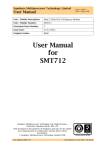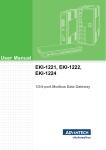Download SMT148FX User Manual - Sundance Multiprocessor Technology Ltd.
Transcript
Sundance Multiprocessor Technology Limited User Manual Form : QCF42 Date : 6 July 2006 Unit / Module Description: Unit / Module Number: SMT148FX-DC, SMT148FX-ATX Document Issue Number: 1.4 Issue Date: 3/8/09 Original Author: GKP User Manual for SMT148FX DC and ATX versions Sundance Multiprocessor Technology Ltd, Chiltern House, Waterside, Chesham, Bucks. HP5 1PS. This document is the property of Sundance and may not be copied nor communicated to a third party without prior written permission. © Sundance Multiprocessor Technology Limited 2006 User Manual SMT148FX Page 1 of 48 Last Edited: 03/08/2009 11:42:00 Revision History Issue Changes Made Date Initials 1.0 First release 4/6/07 GKP 1.1 Minor updates 2/7/07 GKP 1.2 Update LVDS FPGA connectivity. 20/8/07 GKP Added LVDS buffer drawing. 20/8/07 GKP Differentiated DC and ATX versions. 13/6/08 GKP 3/7/08 GKP 19/8/08 GKP 3/8/09 FS 1.2.1 1.3 1.3.1 Corrected LVDs connector pin-out tables. Added additional detail about IL715 isolators. 1.3.2 1.4 Added connector info for RS485. Spartan firmware explanation Important comments or cautions are displayed next to this symbol. User Manual SMT148FX Page 2 of 48 Last Edited: 03/08/2009 11:42:00 Table of Contents 1 Introduction ..................................................................................................................... 5 2 Related Documents ........................................................................................................ 6 2.1 3 Referenced Documents.............................................................................................. 6 Acronyms, Abbreviations and Definitions .............................................................. 6 3.1 4 Acronyms and Abbreviations ................................................................................... 6 Functional Description.................................................................................................. 7 4.1 Block Diagram.............................................................................................................. 7 4.1.1 Virtex 4 FX ............................................................................................................... 8 4.1.2 Spartan 3.................................................................................................................. 8 4.1.3 TIM Sites................................................................................................................... 8 4.1.4 10/100/1000 Ethernet Phy................................................................................... 8 4.1.5 LVDS Isolators......................................................................................................... 9 4.1.6 Firewire................................................................................................................... 12 4.1.7 USB2........................................................................................................................ 12 4.1.8 RS232...................................................................................................................... 14 4.1.9 Flash........................................................................................................................ 14 4.1.10RS485...................................................................................................................... 15 4.1.11SHB .......................................................................................................................... 15 4.1.12LEDs ........................................................................................................................ 15 4.1.13ZBT Memory .......................................................................................................... 15 4.1.14RSL .......................................................................................................................... 16 4.1.15External ComPorts ............................................................................................... 17 4.1.16Internal ComPorts ................................................................................................ 19 4.1.17Power input (DC version).................................................................................... 20 4.1.18Power input (ATX version).................................................................................. 21 4.1.19Power output......................................................................................................... 22 4.1.20JTAG........................................................................................................................ 22 4.1.21Local Clock for ADCs etc. ................................................................................... 23 4.1.22Fan Power............................................................................................................... 23 4.1.23Reset Scheme ........................................................................................................ 23 4.1.24External FPGA Clock Input ................................................................................. 24 4.1.25FPGA (Virtex4 and Spartan) configuration ...................................................... 24 5 Jumper Position/Function.......................................................................................... 25 6 Footprint ......................................................................................................................... 26 6.1 Top View ..................................................................................................................... 26 User Manual SMT148FX Page 3 of 48 Last Edited: 03/08/2009 11:42:00 6.2 Bottom View............................................................................................................... 27 7 Virtex4 FPGA Pin Allocation...................................................................................... 28 8 Virtex4 FPGA Bank Allocation .................................................................................. 29 9 Programming the Cpld ................................................................................................ 31 10 Application to program the Flash ............................................................................ 32 10.1 Connections provided on the SMT148FX ............................................................. 32 11 Accessing the Flash...................................................................................................... 33 11.1 Programming the Spartan ....................................................................................... 33 11.2 Erase and Program of the Flash ............................................................................. 33 11.3 Booting the Spartan and Virtex 4 from flash ...................................................... 34 12 Firmware for the Spartan. .......................................................................................... 34 12.1 Hardwired comport connections ........................................................................... 36 13 RSL and Comport connections .................................................................................. 37 13.1 RSL connections ........................................................................................................ 37 13.2 Comport connections............................................................................................... 39 14 Spartan firmware explanation................................................................................... 42 15 DIP Switches .................................................................................................................. 45 16 Support Packages ......................................................................................................... 46 17 Physical Properties....................................................................................................... 46 18 Thermal Management.................................................................................................. 47 19 Safety ............................................................................................................................... 48 20 EMC .................................................................................................................................. 48 21 Ordering Information .................................................................................................. 48 User Manual SMT148FX Page 4 of 48 Last Edited: 03/08/2009 11:42:00 1 Introduction The SMT148FX is a four site stand-alone TIM carrier board with several external interfaces. Connectors are provided to interface to: • RS232 – From FPGA or USB controller • LVDS (48 pairs) • JTAG • RSL • SATA – Connectors carrying RSL signals only. • SHB • RS485 (16 pairs) • USB2 • Firewire (1394) interface only (No IP core). • Ethernet 10/100/1000 • LED (x32) • ZBT memory • Local clock buffer/generator output User Manual SMT148FX Page 5 of 48 Last Edited: 03/08/2009 11:42:00 Sundance Multiprocessor Technology Limited User Manual Form : QCF42 Date : 6 July 2006 2 Related Documents 2.1 Referenced Documents Sundance SLB specification (hyperlink). Sundance RSL specification (hyperlink). Datasheets as specified above. Texas Instruments Module specification. SMT118: Carrier with 3 Module sites and I/O facilities. SMT180: Carrier with 8 Module sites. 3 Acronyms, Abbreviations and Definitions 3.1 Acronyms and Abbreviations A list of acronyms etc (hyperlink). User Manual SMT148FX Page 6 of 48 Last Edited: 03/08/2009 11:42:00 User Manual SMT148FX 4 lanes 4 lanes SATA connectors x4 RSL connector Page 7 of 48 JTAG header LEDs x32 Firewire connector IEEE1394 PHY FPGA Virtex4 XC4VFX60 FF1152 package 1.2V core LVDS connectors x4 Ethernet PHY RJ45 8x 6-bit 16-bit RS485 connector ZBT memory 2x 2Mx18 Global Bus 3x ComPorts Flash memory 2x 16-bit SHB FPGA Spartan 3 ComPort switch Select map port External ComPorts x4 via SHB connectors External ComPort via 26-way 3m header JTAG CPLD FPGA configuration control JTAG USB2 5x ComPorts SHB connector JTAG Select map port USB connector RS232 connector 16x ComPorts TIM sites x4 TIM sites x4 TIM sites x4 TIM sites x4 4 Functional Description 4.1 Block Diagram Last Edited: 03/08/2009 11:42:00 4.1.1 Virtex 4 FX The primary controlling device on the 148FX is the Xilinx Virtex4 FX60 FPGA. This device is an FF1152 package which provides 16 MGTs (high speed serial I/O) and 576 normal I/O signals. This device can be configured via a Xilinx compatible JTAG header. In normal operation, this device is configured by the CPLD (XC2C512). The configuration data is stored in flash memory, and is loaded using slave SelectMAP mode (8-bit parallel). 4.1.2 Spartan 3 The Xilinx Spartan 3 device is similar in nature to that employed on the SMT150Q and SMT329 carrier boards. It acts as a pre-configured ComPort routing switch. Different ComPort routing schemes are easy to implement using supplied tools (requires Xilinx ISE development software). This device is also configured by the CPLD, and uses slave SelectMAP mode (8-bit parallel), but is also part of the Xilinx JTAG chain. 4.1.3 TIM Sites The 148FX provides 4 TIM sites. In addition to the standard specification requirements, the 148FX also provides the 3.3V supply to the two TIM mounting holes. Each TIM site has 4 ComPorts connected directly to the Spartan 3 device. The two remaining ComPorts are used to create a simple pipe, with each site connecting to its nearest neighbours. The TIM site’s interrupt, timer, config, and reset pins are all connected to the Virtex 4 FPGA. The reset signals are asserted during power-up, when pressing the on-board reset button, or when signalled to via one of the external ComPort connectors. A global bus connection (16 bit data, 12 bit address) is also made from each site to the Virtex 4. The global bus connector normally contains one 16-bit SDB interface (this is unlike the TIM specification which describes the global bus as an Address/Data structure). These SDBs are the primary method of communication to the resources shared by the Virtex 4 (eg. USB, Firewire, etc). 4.1.4 10/100/1000 Ethernet Phy A Marvell Ethernet PHY connects directly to the Virtex 4 FPGA. This interfaces to a 10/100/1000 network via a standard RJ45 socket. This socket has built-in magnetics. The PHY is controlled by a MAC within the Virtex 4. An Ethernet IP core is not supplied in the standard firmware. Please contact Sundance for further information. User Manual SMT148FX Page 8 of 48 Last Edited: 03/08/2009 11:42:00 4.1.5 LVDS Isolators 48 single ended signals are connected from the Virtex 4 to LVDS drivers and receivers (SN65LVDS390/1) via galvanic isolators (type IL715-3). The transmitter part is enabled via control signals. The LVDS outputs are arranged in groups of 6., hence there are 8 control signals. The LVDS receivers are enabled continuously. The isolation provided is up to 150V rms maximum. The isolation provided is up to 150V rms, whilst still enabling a baud rate of up to 100Mbps. The LVDS transmitters and receivers are external to the FPGA itself. The devices used are SN65LVDS390 and 391. LVTTL input from FPGA Output Enable (goes to 3 drivers) LVTTL input from FPGA TX+ Differential output to D-connector LVDS driver TX- LVTTL output to FPGA RX+ Differential input from D-connector LVDS receiver RX100 Ohm termination resistor The IL715-3 galvanic isolators require a simple initialisation sequence before use. Simply toggle the driving pins from the FPGA to the IL715-3 devices at start-up. User Manual SMT148FX Page 9 of 48 Last Edited: 03/08/2009 11:42:00 Typically. The TIMs are configured to route their McBSPs to the global bus connector pins, which, in turn, are routed to the LVDS I/O. The following table shows the pinout for the 37-way D-type connectors. This is only applicable if the TIM is using nonstandard firmware which routes McBSP signals onto the global bus. Contact Sundance for further information. GND Input/Output 20 GND McBSP_CLKR_Tx_0+ I 21 McBSP_CLKR_Tx_0- 3 McBSP_FSR_Tx_0+ I 22 McBSP_FSR_Tx_0- 4 McBSP_DR_Tx_0+ I 23 McBSP_DR_Tx_0- 5 GND 1 2 24 GND McBSP_CLKX_Tx_0+ O 25 McBSP_CLKX_Tx_0- 7 McBSP_FSX_Tx_0+ O 26 McBSP_FSX_Tx_0- 8 McBSP_DX_Tx_0+ O 27 McBSP_DX_Tx_0- 9 GND 28 GND 10 GND 11 GND 6 29 GND McBSP_CLKR_Tx_1- I 30 McBSP_CLKR_Tx_1+ 13 McBSP_FSR_Tx_1- I 31 McBSP_FSR_Tx_1+ 14 McBSP_DR_Tx_1- I 32 McBSP_DR_Tx_1+ 15 GND 12 33 GND McBSP_CLKX_Tx_1- O 34 McBSP_CLKX_Tx_1+ 17 McBSP_FSX_Tx_1- O 35 McBSP_FSX_Tx_1+ 18 McBSP_DX_Tx_1- O 36 McBSP_DX_Tx_1+ 19 GND 37 GND 16 User Manual SMT148FX Page 10 of 48 Last Edited: 03/08/2009 11:42:00 As the LVDS drivers are connected directly to the FX60 FPGA, they can be driven from this device without need for the above McBSP method. The following table shows the connectivity between the FPGA and the D-connectors (P2, 3, 4 & 5): DConn Pin DConn Pin Signal GND 1 20 GND Signal FPGA signal pin P2 P3 P4 P5 FPGA enable pin D29 K29 M26 P31 RX0+ 2 21 RX0- F31 C32 L30 P26 RX1+ 3 22 RX1- E32 D32 L31 P27 RX2+ 4 23 RX2- GND 5 24 GND D31 E29 K31 M31 TX0+ 6 25 TX0- E31 F29 K32 M32 TX1+ 7 26 TX1- C29 J29 M25 P30 TX2+ 8 27 TX2- GND 9 28 GND GND 10 GND 11 29 GND C30 L28 M28 P29 RX3- 12 30 RX3+ D30 L29 N27 R29 RX4- 13 31 RX4+ G31 H29 M30 R27 RX5- 14 32 RX5+ GND 15 33 GND H28 J31 J32 P32 TX3- 16 34 TX3+ F30 J27 N28 R31 TX4- 17 35 TX4+ G30 K28 N29 R32 TX5- 18 36 TX5+ GND 19 37 GND P2 P3 P4 H27 J30 G32 H30 N30 P5 H32 N32 R28 The LVDS transmitters are enabled in groups. Two groups per D-connector. Eg. FPGA pin J30 is the transmitter enable for connector P3’s TX pins. The LVDS receivers are continuously enabled and terminated by a 100 Ohm resistor. User Manual SMT148FX Page 11 of 48 Last Edited: 03/08/2009 11:42:00 4.1.6 Firewire A single IEEE1394 interface is provided by an Agere FW801A PHY. The following table shows the pinout of the connector; 1 Cable Power 2 GND 3 TPB- 4 TPB+ 5 TPA- 6 TPA+ This will allow high speed firewire data to be routed directly to the FPGA. The standard FPGA firmware does not include an IEEE1394 IP core. These are available from 3rd parties. Please contact Sundance for further information. 4.1.7 USB2 The USB2 interface is provided by the Cypress CY7C68013A device. The Cypress part, in addition to providing USB functions with a FIFO type interface, also contains a USART, and an 8051 micro-controller. The USB connector pin-out is shown here; 1 USB_ind 2 Data- 3 Data+ 4 GND The interface provided by this controller looks identical to a 16-bit SDB interface, and is routed directly to the Spartan FPGA and the CPLD. The standard Cypress firmware does not include functions to control the USART. Please contact Sundance for further information. The following table shows the Cypress pin connectivity to the Sundance SDB signal; User Manual SMT148FX Page 12 of 48 Last Edited: 03/08/2009 11:42:00 User Manual SMT148FX SDB Signal Cypress Pin CLK IFCLK D0 PB0 D1 PB1 D2 PB2 D3 PB3 D4 PB4 D5 PB5 D6 PB6 D7 PB7 D8 PD0 D9 PD1 D10 PD2 D11 PD3 D12 PD4 D13 PD5 D14 PD6 D15 PD7 WEN RDY0 REQ CTL2 ACK RDY1 UD0 PA7 UD1 RDY3 Page 13 of 48 Last Edited: 03/08/2009 11:42:00 4.1.8 RS232 Two devices generate RS232 data (simple TX and RX); the FPGA and the USB2 controller. The Rx data pin from a 9-way D-type connector is connected to both serial interfaces. The Tx data pin from each device is routed to a jumper block (JP12) which allows the selection of one Tx data output. The RS232 levels are generated using a MAX3227 converter. 1 2 Rx 3 Tx 4 5 GND 6 7 8 9 Insert only one jumper in positions shown in section 7. 4.1.9 Flash The flash memory connected to the CPLD and contains configuration data for the two FPGAs. Any additional space within this device can be used to store application programs. The flash can be directly programmed by the CPLD only. The external ComPort is directly connected to the CPLD. This allows the reprogramming of the flash using an identical procedure as that employed on the SMT348. After configuration, the CPLD ComPort is tri-stated and the external ComPort functions as an input to the ComPort switch (Spartan 3). User Manual SMT148FX Page 14 of 48 Last Edited: 03/08/2009 11:42:00 4.1.10 RS485 Each of the 16 RS485 signal pairs is driven by an SN75HVD12. They are arranged into two groups of 8-bits each and have a single control signal which selects the group to be a transmitter or receiver. Connector RS1 carries these signals. Function S0S1S2S3S4S5S6S7GND GND pin 1 3 5 7 9 11 13 15 17 19 pin 2 4 6 8 10 12 14 16 18 20 Function S0+ S1+ S2+ S3+ S4+ S5+ S6+ S7+ GND GND Function GND GND S8S9S10S11S12S13S14S15- pin 21 23 25 27 29 31 33 35 37 39 pin 22 24 26 28 30 32 34 36 38 40 Function GND GND S8+ S9+ S10+ S11+ S12+ S13+ S14+ S15+ 4.1.11 SHB A single SHB connector (Samtec QSH-030-01) provides two independent 16-bit SDBs, or a single 32-bit SDB interface. These signals are connected directly to the FX60. 4.1.12 LEDs 32 LEDs are connected to the Virtex 4 FPGA in a matrix of 8x4. 4.1.13 ZBT Memory Two 16-bit wide ZBT memories are connected directly to the FPGA. This provides a memory bank of 2Mx16 bits (4Mbytes). The standard FPGA firmware does not include functions to control the ZBTRAM. VHDL test code is available. Please contact Sundance for further information. User Manual SMT148FX Page 15 of 48 Last Edited: 03/08/2009 11:42:00 4.1.14 RSL The Virtex 4 FX FPGA provides 16 RSL (Rocket Serial Link) interfaces. 8 of these are connected to the 4 TIM sites (2 per site). Four RSLs are connected to 4 SATA style connectors thus allowing inter-board connectivity. The remaining 4 are presented on a standard RSL connector. See the RSL specification for details on the connector type. The SATA style connectors do NOT provide a SATA interface using the standard Sundance FPGA firmware. RSL interfaces provide a high-speed (250Mbytes/s per link) bi-directional connection. Fast communication between TIMs should use these links wherever possible. User Manual SMT148FX Page 16 of 48 Last Edited: 03/08/2009 11:42:00 4.1.15 External ComPorts Four ComPorts are connected to SHB style connectors. Two output-type ComPorts (0 and 1), and two input-type ComPorts (3 and 4) are provided. All 4 ComPorts are connected to both SHB-style connectors. Connector A is arranged 0, 1, 3 and 4, and connector B 3, 4, 0 and 1. With this scheme, a simple one-to-one SHB cable can be used to connect connector A on one 148FX to connector B on another 148FX. External Comports 0, 1, 3 and 4 are routed to two SHB connectors (Samtec QSH-03001) to allow connection to another SMT148FX carrier and its ComPorts. The pin-out is as follow: 1 STRB_0 2 RDY_0 3 REQ_0 4 ACK_0 5 D0_0 6 D1_0 7 D2_0 8 D3_0 9 D4_0 10 D5_0 11 D6_0 12 D7_0 15 STRB_1 16 RDY_1 13 14 17 REQ_1 18 ACK_1 19 D0_1 20 D1_1 21 D2_1 22 D3_1 23 D4_1 24 D5_1 25 D6_1 26 D7_1 27 29 STRB_3 30 RDY_3 31 REQ_3 32 ACK_3 33 D0_3 34 D1_3 35 D2_3 36 D3_3 37 D4_3 38 D5_3 39 D6_3 40 D7_3 43 STRB_4 44 RDY_4 41 42 28 45 REQ_4 46 ACK_4 47 D0_4 48 D1_4 49 D2_4 50 D3_4 51 D4_4 52 D5_4 53 D6_4 54 D7_4 55 56 59 60 57 58 RESET Compatible with the 148 and 148LT, an active low RESET signal is provided. When two 148FX boards are interconnected with a 60 way cable assembly, the RESET is propagated from one 148FX to the other. User Manual SMT148FX Page 17 of 48 Last Edited: 03/08/2009 11:42:00 Another ComPort is available via a 26-way connector, where cable SMT502 can be used to connect to a SMT310Q and download applications from a PC. This connector has the following pin-out. User Manual SMT148FX 1 CSTRB 2 GND 3 CRDY 4 GND 5 CREQ 6 GND 7 CACK 8 GND 9 D0 10 D1 11 D2 12 D3 13 D4 14 D5 15 D6 16 D7 17 3.3V 18 GND 19 /RESETOUT 20 GND 21 /RESETIN 22 GND 23 NC 24 NC Page 18 of 48 Last Edited: 03/08/2009 11:42:00 4.1.16 Internal ComPorts Each TIM site has 6 ComPorts. Four of these are connected directly to the Spartan 3 FPGA. These are ComPorts 0, 1, 3 & 4. ComPorts 2 & 5 are connected between TIM sites in a pipe configuration as follows; TIM1 ComPort 2 connects to TIM2 ComPort 5 TIM2 ComPort 2 connects to TIM3 ComPort 5 TIM3 ComPort 2 connects to TIM4 ComPort 5 TIM4 ComPort 2 connects to TIM1 ComPort 5 User Manual SMT148FX Page 19 of 48 Last Edited: 03/08/2009 11:42:00 4.1.17 Power input (DC version) Power is supplied from an external source. The voltage of the external source needs to be in the range +18V to 30V. This enters the board via an 8-pin connector (Receptacle, mini fit 8 Way, Molex) JP14. +18-30V 1 +18-30V 2 +18-30V 3 +18-30V 4 GND 5 GND 6 GND 7 GND 8 Table 1 : Power in connector pinout The external source is input to a DC-DC converter module, which produces +/-12V to the TIM sites. It is also used as an input to two DC-DC converters that produce the +5V, +3.3V, +2.5V and 1.5V supply to the TIM sites, carrier FPGA and other onboard devices. When using a +24V input, the power consumption of an unpopulated SMT148X is approximately 6W. Alternatively, the input power can be provided at +9 to 18V (using alternative DCDC parts). Contact Sundance for further information. The fan connectors, FAN1-4, are powered directly from the input supply. User Manual SMT148FX Page 20 of 48 Last Edited: 03/08/2009 11:42:00 4.1.18 Power input (ATX version) Power is supplied directly from an ATX style power supply connected to JP15. Note that most off-the-shelf PC ATX power supplies have a minimum load rating for their +12V output. Typically, this can be about 1A. Fitting a couple of cooling fans is often sufficient. Alternatively, there are zero load power supplies available. Eg. Lambda NV-175 series (NV1-453TTH-N3-I). Sundance are able to provide a power harness for this model. The fan connectors, FAN1-4, are powered at +12V. The ATX Power Connector Pin-Out is shown here: Main 20 pin connector: Name Pin Pin Name +3.3V 1 11 +3.3V +3.3V 2 12 -12V GND 3 13 GND +5V 4 14 ON (input) GND 5 15 GND +5V 6 16 GND GND 7 17 GND - 8 18 - - 9 19 +5V +12V 10 20 +5V Extension for BTX: User Manual SMT148FX +12V +5V +3.3V GND Page 21 of 48 Last Edited: 03/08/2009 11:42:00 4.1.19 Power output Power can be supplied to external devices or modules. The 8-pin connector (Receptacle, mini fit 8 Way, Molex) JP16 provides several voltages and has the following pinout: Pin number -12V 1 +12V 2 +5V 3 +3.3V 4 GND 5 GND 6 GND 7 Key 8 Table 2 : Power out pinout Connector position 8 is filled to prevent plugging in the power input cable (the connectors are the same type). A modified plug (pin 8 removed) must be used for power output. 4.1.20 JTAG A single JTAG chain connects all 4 TIM sites and the JTAG in & out connectors. This chain is used with the TI Code Composer Studio software suite. Although in essence it is a chain, the chain exists internally to a Xilinx CPLD. The CPLD drives and receives signals to the 4 TIM sites independently. This allows JTAG clock frequencies in excess of 30MHz to work reliably. The JTAG-out (JTAG2) connector can be connected to the JTAG-in (JTAG1) connector of other SMT148FX, thus extending the chain (see cable SMT503). All JTAG chaining and TIM bypass is performed within the CPLD. User Manual SMT148FX Page 22 of 48 Last Edited: 03/08/2009 11:42:00 4.1.21 Local Clock for ADCs etc. The full functionality of the SMT399-F is also included. This comprises an external clock input, phase shifter, local OCXO, and 4-way power splitter. Selection between local OCXO and VGA is made with the position of a 0 Ohm resistor link. This link (labelled R125) is located on the reverse of the board near the RS232’s 9-way d-connector. Moving this link will not invalidate any warranty. Some soldering is necessary to select between the two options. J1-4 are outputs from a power splitter which is fed from the OCXO. These outputs are intended for the Sundance range of ADC/DAC modules. Connector J5 is used for an external clock input which enters the VGA (variable gain amplifier). 4.1.22 Fan Power Four two-pin connectors are provided to supply fans using power directly from the power input connector. Note that if power is provided via an ATX type supply, then these fan connectors will be powered at +12V. 4.1.23 Reset Scheme A power rail monitor observes the state of the 3.3V supply. This device will generate a reset to the SMT148FX (RESET148) during power-up or if the 3.3V supply drops below 3V. This signal is an open-collector output and is also driven to the inter-card ComPort connector, and thus to another SMT148FX. The POR (power on reset) signal is driven to the RESETOUT pin on the external ComPort1 connector. The RESETIN pin on the above connector is buffered by an open-collector device which in turn can also drive the RESET148 signal. An additional 4 pin header is provided to allow other devices to share the opencollector RESET148 signal. The TIM reset pins are connected to the FPGA and will be reset when RESET148 is active as well as when some firmware conditions trigger a reset to the different TIMs (see Firmware description for more details about TIM reset). User Manual SMT148FX Page 23 of 48 Last Edited: 03/08/2009 11:42:00 4.1.24 External FPGA Clock Input Located near the DSP JTAG headers, connector J6 provides a direct connection to the FPGA pin H17. This has 50 Ohm termination and is suitable for LVTTL (maximum 3.3V) signals only. 4.1.25 FPGA (Virtex4 and Spartan) configuration The Virtex4 FPGA can be configured from flash, USB or ComPort. This is determined by the setting of switch bank SW3, and is detailed in the following table. Note that SW4-1 must be set to OFF. The Jumpers [1-2] of SW3 control the Spartan configuration The Jumpers [3-4] of SW3 control the Virtex4 configuration. SW3 Position 2 or 4 Position 1 or 3 Flash ON ON Comport OFF ON USB ON OFF Examples: Virtex 4 Spartan 4 3 2 1 Both devices configure from Flash. ON ON ON ON Direct configuration via USB. ON OFF ON OFF SW3 (needs a host application to send the bitstreams via USB) Configuration of Spartan via Flash and of Virtex 4 via CP3 OFF connected to TIM site 1 CP0. ON ON ON The Spartan is always the device configured first. It is possible to download a new configuration to the FPGA using a Xilinx JTAG cable connected to a PC and to JP6 on the SMT148FX carrier. This uses the standard 14way ribbon cable supplied by Xilinx. Refer to Xilinx document DS300 v3.1 page 8 for details of the pinout. User Manual SMT148FX Page 24 of 48 Last Edited: 03/08/2009 11:42:00 5 Jumper Position/Function User Manual SMT148FX Page 25 of 48 Last Edited: 03/08/2009 11:42:00 6 Footprint 6.1 Top View User Manual SMT148FX Page 26 of 48 Last Edited: 03/08/2009 11:42:00 6.2 Bottom View User Manual SMT148FX Page 27 of 48 Last Edited: 03/08/2009 11:42:00 7 Virtex4 FPGA Pin Allocation USB2 controller Firewire / OXUF922 CLK 1 Data 16 Control 3 User Def 2 All Address SHB/SDB 12 Data 8 Control 3 Data 16 22 SDB type interface 29 IDE interface to OXUF922 23 From OXUF922 V4 Configuration data 2 48 2 x 16-bit data. Control 3 WEN, REQ, ACK. User 4 USER0-3 Clock 1 RS485 All 18 16 data and two control. LVDS All 56 8 groups of 7, normally routed to McBSPs via FPGA. ComPorts All 48 To Spartan3. LEDs All 12 8 x 4 matrix. Ethernet PHY All 12 4-bit data + 2 control for each direction. 12 4 4 Global Bus TIM misc Address 12 Data 16 4 TCLK 2 Config 1 IIOF,NMI 4 IACK 1 Reset 1 Individual resets to TIM sites. Clock 3 CLKIN, H1 and H3. All ZBT Address 20 Data 32 Control+Clk 10 Other User Manual SMT148FX 128 Control RS232 Spartan3 4 RST, COMA, MDC and MDIO. STRB, RW, PAGE, RDY 4 48 2 1 Tx + Rx. 62 FPGA config 3 PROG, CCLK, DIN Data Interface 4 CLK25, PXCLK, PXDATA, PXLOAD Reset 1 From V4 2 BDRESET, CLK50 Page 28 of 48 Last Edited: 03/08/2009 11:42:00 8 Virtex4 FPGA Bank Allocation Interface Bank Comment Global Bus A 5 12 Address, 16 Data, 4 Control (STRB, RDY, WR, PAGE) Global Bus B 6+10 12 Address, 16 Data, 4 Control (STRB, RDY, WR, PAGE) Global Bus C 8 12 Address, 16 Data, 4 Control (STRB, RDY, WR, PAGE) Global Bus D 11 12 Address, 16 Data, 4 Control (STRB, RDY, WR, PAGE) ZBT Bank 1 10 Clock uses GCK on bank ZBT Bank 2 12 Clock uses GCK on bank Ethernet 12 SHB 7 RS485 7+8 Direction control is on bank 8. ComPorts 11+5 2 ports per bank used. LVDS 9 USB 8 LEDs 5+9 Misc, TIM 1+3+4 RS232 5 RST, Clock 5 IEEE1394 6 TIM reset 11 V4 to S3 interface User Manual SMT148FX Appears as a 16 bit SDB. 8 Tx, Rx. CLK, DATA, LOAD, RESET Page 29 of 48 Last Edited: 03/08/2009 11:42:00 This is shown graphically here, User Manual SMT148FX Page 30 of 48 Last Edited: 03/08/2009 11:42:00 9 Programming the Cpld The cpld firmware is necessary to access the flash and to configure the SMT148-FX FPGAs.. Please use Xilinx download cable to download the cpld jedec file top.jed. Select the CPLD XC2C512 from the 3 components and download the file top.jed. • It can be found in: $\Program Files\Sundance\SMT6048\ FlashProgramming This is a one off operation. Figure 1:SMT148FX JTAG chain User Manual SMT148FX Page 31 of 48 Last Edited: 03/08/2009 11:42:00 10 Application to program the Flash The Host can access the SMT148FX flash via the USB. Before the Spartan is configured, the CPLD provides a link to the USB. It also is the Flash controller. 10.1 Connections provided on the SMT148FX Flash control signals and address bus Flash control Common signals and buses for configuration purposes Configuration data Flash Independent configuration signals Common Configuration signals and data bus D[7:0], CCLK, RDWR_B Coolrunner II CPLD Independent configuration/control signals Independent configuration/control signals Independent configuration/control signals Spartan 3 Switch control signals Virtex4Fx BUFFERED COMPORT 3 Configuration Switch SMT148FX User Manual SMT148FX USB DEVICE B U F F E R E D C O M P O R T 3 BUFFERED COMPORT 3 USB DEVICE U S B D E V I C E Page 32 of 48 Last Edited: 03/08/2009 11:42:00 11 Accessing the Flash This section describes the various steps to follow to access the Flash. 11.1 Programming the Spartan Set the switches of the SMT148FX with SW3 [4-3-2-1]= ON ON ON ON and SW4[4-3-2-1] = OFF OFF OFF ON. SW4 [1] ON provides Programming and erase accesses of the Flash. SW4 [1] OFF disables these accesses and enables read accesses only of the Flash in a view to program the FPGAs. Reset or power off and on the SMT148FX evytime you change the switch settings.. 11.2 Erase and Program of the Flash Sundance provides 2 download utilities: • • The SMT6002 is a free utility downloadable with the Sundance wizard. o The Spartan firmware MUST be located at address 0x0. o The Virtex 4 firmware MUST be located at address 0x800000. The SMT6048 package provides a host utility called FlashUtility.exe. o Tick the option for the relevant FPGA and you can delete/ program a new firmware for it. Browse to the firmware of your choice for the SMT148FX Spartan or the Virtex 4(after the next power up, it will be loaded from Flash in the Spartan and/or the Virtex4.) It can be found in: $\Program Files\Sundance\SMT6002\Firmware\Smt148FX You always need to delete the current bitstream before replacing it with a new bitstream in Flash. Deleting a bitstream is quick, but erasing the whole flash can take 2 minutes. Programming takes about 1 minute. User Manual SMT148FX Page 33 of 48 Last Edited: 03/08/2009 11:42:00 11.3 Booting the Spartan and Virtex 4 from flash Then set the switch SW4[4-3-2-1] = OFF OFF OFF OFF. The Spartan and Virtex 4 will configure from Flash next time you issue a hard reset or power on the SMT148FX. Any Spartan design available flashes led 2 while the Virtex4 example design provided flashes the whole raw of leds next to led2. 12 Firmware for the Spartan. It can be found in: $\Program Files\Sundance\SMT6002\Firmware\Smt148FX The default firmware “com.sundance.smt148-fx.sc3s1500.usb_default.app” present in flash, enables default comport connections between TIM sites and a direct connection between USB and TIM site 1 comport 3. The connections are represented by Figure 2: Default bitstream comport configuration. More firmware are available to allow different TIM connections. The default_anticlockwise firmware “com.sundance.smt148-fx.sc3s1500.usb_default_anticlockwise.app” provides the same comport connections as before, but this time going from TIM1 to TIM4 to TIM3 to TIM2 to TIM1. The default_dual_TIM firmware “com.sundance.smt148-fx.sc3s1500.usb_default.dual_TIM.app” provides the same comport connections as before, but this time going from TIM4 to TIM1 to TIM2 to TIM3 to TIM4. For more advanced use, the SMT148-FX Virtex4 FPGA is available for customisation A custom firmware for the Spartan to show that the Virex 4 can be part of the network of processors in a Diamond application is provided with “com.sundance.smt148-fx.sc3s1500.Tim2Cpld.app”. The comport link used between TIM1 and the virtex4 is TIM1 CP0 to Virtex4 CP3. (this link is only for configuration and not yet available as a valid link after configuration…will be in the next release). Another link is declared and can be used for communicaton once the application is loaded. The connections made are TIM1 CP4 to Virtex4 CP1. Feel free to make a Diamond application including a TIM on TIM site 1 and a design on the Virtex 4. Use the Diamond server to load the .app and you should see the virtex 4 configuring. (do not forget to check the SMT148-FX switches) User Manual SMT148FX Page 34 of 48 Last Edited: 03/08/2009 11:42:00 A new firmware can be made for you or you can get the project to allow you to customise the Spartan at will… 0 3 1 4 TIM SITE 4 TIM SITE 3 TIM SITE 2 TIM SITE 3 TIM SITE 1 TIM SITE 2 3 4 1 0 0 1 4 3 TIM SITE 1 TIM SITE 2 TIM SITE 1 TIM SITE 4 TIM SITE 4 TIM SITE 3 4 3 1 0 Implementation in the bitsream entitled “default_anticlockwise” Fx2lp Implementation in the bitsream entitled “default” Usb cable Implementation in the bitsream entitled “default.dual_TIM” Figure 2: Default bitstream comport configuration. User Manual SMT148FX Page 35 of 48 Last Edited: 03/08/2009 11:42:00 12.1 Hardwired comport connections A hardwired comport pipe is implemented between TIM sites. It links the TIM sites in a clockwise manner using comport 2 and comport 5 as per Figure 3. TIM SITE 2 TIM SITE 1 2 5 5 2 2 5 5 2 TIM SITE 3 TIM SITE 4 PCB Comport connections between TIM sites Figure 3: PCB comport connections between TIM sites User Manual SMT148FX Page 36 of 48 Last Edited: 03/08/2009 11:42:00 13 RSL and Comport connections 13.1 RSL connections Figure 4: Virtex 4 RSL connections User Manual SMT148FX Page 37 of 48 Last Edited: 03/08/2009 11:42:00 Figure 5: PCB RSL connections between TIM sites Figure 6: PCB RSL connections between TIM sites User Manual SMT148FX Page 38 of 48 Last Edited: 03/08/2009 11:42:00 13.2 Comport connections Figure 7: PCB comport connections between TIM sites User Manual SMT148FX Page 39 of 48 Last Edited: 03/08/2009 11:42:00 Figure 8: Spartan comport connections Figure 9: Spartan comport connections User Manual SMT148FX Page 40 of 48 Last Edited: 03/08/2009 11:42:00 Figure 10: Spartan to Virtex 4, CPLD and USB comport connections The comport used to configure the Virtex 4 can’t be re-used after the FPGA configuration. It’s why the comport 5 is used in a Diamond project, this comport is not connected on the PCB. If you select one of the three comport available on the Virtex 4 as its configuration comport, you will not be able to use this comport for data transfer after the FPGA configuration. User Manual SMT148FX Page 41 of 48 Last Edited: 03/08/2009 11:42:00 14 Spartan firmware explanation Sundance provides many Spartan firmwares; you can design your own firmware in following the next instructions. Figure 11: Default Spartan firmware project The firmware must contain the clock manager task: SMT148FX_CM The clock domain named here ifclk must be used for all the tasks and all the connections. The SMT148FX_CM task is used to generate this clock domain at 48MHz; it’s the only one that uses the default clock. The heartbeat_wrapper_ngc task corresponds to the LED Spartan status; this task just has to be added to the project and doesn’t need any connection. The fx2lprxtx_ngc task corresponds to the USB connection, connect this task to your root processor location, for the default firmware, it’s T1CP3. Between all the connections you must add a pipe_wrapper_ngc task. You have to connect the two comport direction, for example with the default firmware, for the connection between the USB and the T1CP3 we will have: • fx2lprxtx_ngcÙ pipe_wrapper_ngc_1Ùroot CP:2(TX) • root CP:2(TX) Ù pipe_wrapper_ngc Ù fx2lprxtx_ngc The Spartan comport connection is list in the following table. User Manual SMT148FX Page 42 of 48 Last Edited: 03/08/2009 11:42:00 TIM Site 1 TIM Site 2 TIM Site 3 TIM Site 4 Virtex 4 comports root CP:0 root CP:1 root CP:2 root CP:16 T1CP0 T1CP1 T1CP3 T1CP4 root CP:4 root CP:5 root CP:6 root CP:7 T2CP0 T2CP1 T2CP3 T2CP4 root CP:8 root CP:9 root CP:10 root CP:11 T3CP0 T3CP1 T3CP3 T3CP4 root CP:12 root CP:13 root CP:14 root CP:15 T4CP0 T4CP1 T4CP3 T4CP4 root CP:21 root CP:22 root CP:23 V4CP0 V4CP1 V4CP3 root CP:17 root CP:18 root CP:19 root CP:20 JPCP0 JPCP1 JPCP3 JPCP4 root CP:3 Virtex 4 configuration CBUF Connection to another SMT148FX Table 3: Spartan connections Don’t forget to edit all the connection and select the ifclk clock domain and select the right link starts up properties. Figure 12: Connection properties At reset you must connect a comport from RX to TX or TX to RX. For the default firmware, the T1CP3 of the TIM root processor is RX at reset, to get its bitstream. The Spartan firmware comport (root CP:2) will have the link starts up as transmitter properties. The next Diagram shows the Default firmware connection with all the connections properties. User Manual SMT148FX Page 43 of 48 Last Edited: 03/08/2009 11:42:00 Figure 13: Default Spartan firmware diagram User Manual SMT148FX Page 44 of 48 Last Edited: 03/08/2009 11:42:00 15 DIP Switches SW4 1 Programming/Erase of the Flash ON Flash Reads in a view to configure FPGAs OFF Table 4: Switch SW4 The Spartan and Virtex 4 configuration sources can be identified using SW3. The Jumpers [1-2] of SW3 are controlling the Spartan configuration The Jumpers [3-4] of SW3 are controlling the Virtex4 configuration. SW3 Flash Jumper 2 or jumper 4 Jumper 1 or Jumper3 ON ON Comport OFF ON USB OFF ON Table 5: Switch SW3. The Comport as a source is a feature only supported for Virtex 4 configuration. Examples: When SW4[1] is OFF: Virtex 4 Spartan SW3 4 3 2 1 Both devices configure from Flash. ON ON ON ON Direct configuration via USB. ON OFF ON OFF (needs a host application to send the bitstreams via USB) Configuration of Spartan via Flash and of Virtex 4 via CP3 OFF ON connected to TIM site 1 CP0. ON ON Table 6: Examples of Switch configuration. The Spartan is always the device configured first. Do not try to configure the Virtex 4 before configuring the Spartan or the configuration will fail. When SW4[1] is ON, SW3[4321] should be set to ON ON ON ON. User Manual SMT148FX Page 45 of 48 Last Edited: 03/08/2009 11:42:00 16 Support Packages To be added. 17 Physical Properties Dimensions 250 x 200mm Weight 350g The following table indicates the power capabilities of the on-board supplies; Option Supply Current A B C +12V 1.67A 0.83A * +5V 10A 10A * +3.3V 10A 10A * -5V 0A 0A * -12V 0A 0.83A * *Option C is with the use of an external ATX power supply. Refer to the relevant power supply specification in this case. MTBF User Manual SMT148FX Page 46 of 48 Last Edited: 03/08/2009 11:42:00 18 Thermal Management Although provision is made to attach DC fans to the SMT148FX (powered directly from the input voltage), correct enclosure air flow should be ensured. Sundance are able to provide a heat-pipe type thermal management solution for two TIM sites (sites 2 and 3). This involves increased height TIM and RSL connectors for these sites, the fixing of the heat-pipe system direct to the TIMs’ components, and the addition of an off-board heatsink and fan. Please consult Sundance for pricing and availability for this option. Several components in both the onboard 3.3V and 5.0V supplies are rated at 125°C maximum. Without adequate cooling, the inductors in this circuit can reach in excess of 170°C when running at full rated load. Some of the major components are located on the underside of the carrier board. This will allow heatsinks (or indeed an enclosure) to be fitted. User Manual SMT148FX Page 47 of 48 Last Edited: 03/08/2009 11:42:00 19 Safety This module presents no hazard to the user when in normal use. 20 EMC This module is designed to operate from within an enclosed host system, which is built to provide EMC shielding. Operation within the EU EMC guidelines is not guaranteed unless it is installed within an adequate host system. This unit is protected from damage by fast voltage transients originating from outside the host system which may be introduced through the output cables. Short circuiting any output to ground (except the bi-directional reset output) does not cause the system to lock up or reboot. 21 Ordering Information Several variations of this product are available. SMT148-FX-DC Standard product with on-board voltage converters. SMT148-FX-ATX Standard product with ATX PSU input connector. SMT148-FX-nn-Fxxx With additional local ADC oscillator. xxx refers to the oscillator frequency. nn refers to power input type. User Manual SMT148FX Page 48 of 48 Last Edited: 03/08/2009 11:42:00
















































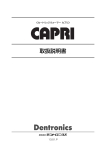

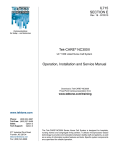
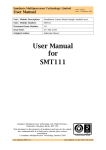

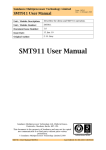

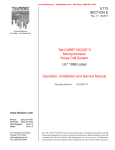


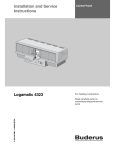

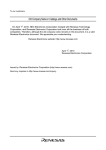
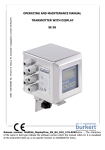
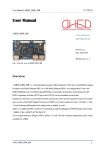

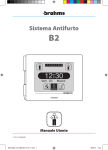
![[APPLICATION FUNCT.] (FUn-) menu](http://vs1.manualzilla.com/store/data/005824711_1-335fb64f289c00db4078a7c61d67b3e9-150x150.png)


